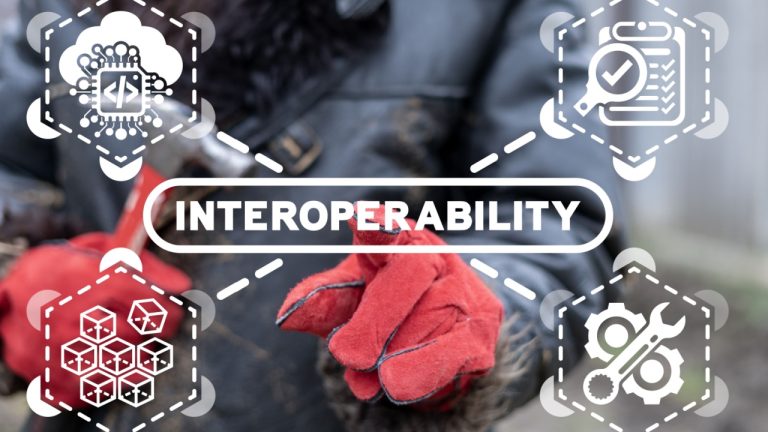 According to Nick Yushkevich, standardization of blockchain data formats is crucial as it enhances the interoperability of distinct protocols and fosters broader adoption of the technology. Yushkevich, the director of product at blockchain infrastructure provider Quicknode, added that such standardization helps to improve communication between systems. Unlocking the Full Potential of Blockchain Data Yushkevich stated […]
According to Nick Yushkevich, standardization of blockchain data formats is crucial as it enhances the interoperability of distinct protocols and fosters broader adoption of the technology. Yushkevich, the director of product at blockchain infrastructure provider Quicknode, added that such standardization helps to improve communication between systems. Unlocking the Full Potential of Blockchain Data Yushkevich stated […] Wormhole, a platform fostering blockchain interoperability within decentralized finance (defi), has unveiled plans for an airdrop of its proprietary token, W. The initiative is part of the protocol’s broader aim toward progressive decentralization, rewarding dedicated users and developers within the Wormhole ecosystem. Wormhole to Airdrop W Token to Advance Defi Interoperability Wormhole, a facilitator of […]
Wormhole, a platform fostering blockchain interoperability within decentralized finance (defi), has unveiled plans for an airdrop of its proprietary token, W. The initiative is part of the protocol’s broader aim toward progressive decentralization, rewarding dedicated users and developers within the Wormhole ecosystem. Wormhole to Airdrop W Token to Advance Defi Interoperability Wormhole, a facilitator of […] On Wednesday, the blockchain interoperability platform Wormhole revealed it is collaborating with the American multinational semiconductor company AMD (Advanced Micro Devices). Wormhole plans to utilize AMD’s Field Programmable Gate Array (FPGA) technology in order to bolster cross-chain communication and multi-chain scalability. AMD’s FPGA Tech to Power Wormhole’s Interoperability Ambitions Wormhole, an interoperability platform for blockchains, […]
On Wednesday, the blockchain interoperability platform Wormhole revealed it is collaborating with the American multinational semiconductor company AMD (Advanced Micro Devices). Wormhole plans to utilize AMD’s Field Programmable Gate Array (FPGA) technology in order to bolster cross-chain communication and multi-chain scalability. AMD’s FPGA Tech to Power Wormhole’s Interoperability Ambitions Wormhole, an interoperability platform for blockchains, […] On Monday, the Web3 blockchain interoperability platform Analog announced the team has raised $16 million in a funding round from a wide array of venture capitalists and firms including Balaji Srinivasan, Tribe Capital, and Wintermute. Furthermore, Analog has launched its Launch Partners Program to bolster the presence and market dominance of cross-chain initiatives. $16 Million […]
On Monday, the Web3 blockchain interoperability platform Analog announced the team has raised $16 million in a funding round from a wide array of venture capitalists and firms including Balaji Srinivasan, Tribe Capital, and Wintermute. Furthermore, Analog has launched its Launch Partners Program to bolster the presence and market dominance of cross-chain initiatives. $16 Million […]
Blockchains need to become interoperable in order for the industry to truly flourish and several innovations will accelerate the ecosystem towards it, say executives.
The future of blockchain will be an interoperable one — with the death of “chain tribalism,” the proliferation of “hundreds of chains” along with an end to cross-chain bridge hacks, according to executives at Korea Blockchain Week.
Backing up the claims are several products slated for release before the end of the year that could see blockchain interoperability efforts move away from current solutions, which execs say don’t make sense and are a “honeypot” for hackers.
Vance Spencer, the co-founder of the crypto-focused venture firm Framework Ventures, told Cointelegraph at KBW that he thinks with many solutions on the horizon, including Chainlink’s Cross-Chain Interoperability Protocol (CCIP), it soon won’t matter what blockchain a project uses.
He said most startups begin on layer-2 solutions such as Optimism or Arbitrum but soon begin to want their own roll-up. “It's like everyone's trying to create the standard,” he said.
Said another way, the interop protocols will accrue more value than L2s themselves over the long term. Especially if there are a lot/too many L2s/chains. The investment is a view on the likely fragmentation of contracts over too many chains, and the value of networking them.
— Vance Spencer (@pythianism) September 7, 2023
In a cross-chain interoperable future, the paradigm will shift and “it's really not gonna matter which roll-up you're on,” Spencer said.
“In the future, it's probably just going to be: ‘Can your contract talk to my contract?’”
Spencer gave the example of CCIP which, he explained, allows a user to have assets on one chain and interact with contracts on another that uses cross-chain messages instead of a blockchain bridge.
ZetaChain core contributor Brandon Truong told Cointelegraph it operates in a similar way to CCIP — the main difference being it’s sent from ZetaChain’s network.
Truong added it sees interoperability becoming standard with new app builders and there will be less “chain tribalism” and more focus on utility.
He added that many older blockchain bridge solutions are “fragmented and often insecure.”
Another product is the upcoming MetaMask Snaps, which will allow developers to launch functionality-expanding apps for the crypto wallet — allowing use with other blockchains, including Bitcoin, Solana, Avalanche and Starknet.
Speaking on a panel at KBW, cross-chain protocol Axelar co-founder Georgios Vlachos believes, at some point, there will be “hundreds of chains” all processing “significant economic activity.”
“At this point, I think it's indisputable given how many people and important companies in this space are building cross-chain and are incentivized to launch their own Layer 1s.”
Vlachos added multiple blockchains are needed as he believes a single blockchain won’t be capable of more than 10 million transactions per day — far below the nearly 530 million daily average transactions payments giant Visa processed in 2022.
Cross-chain … is only the beginning https://t.co/ogJ3DU2R5d
— Axelar Network (@axelarcore) September 11, 2023
“If we want to become foundational architecture for Web2 we need to scale this by an order of magnitude and this is really, really hard,” he said.
“The answer is to scale horizontally and create many, many different blockchains.”
Currently, users wanting to send assets between networks largely use blockchain bridges which Router Protocol founder and CEO Ramani “Ram” Ramachandran thinks are prone to hacks and will soon be replaced by other cross-chain solutions — including one by his protocol.
Ramachandran explained to Cointelegraph at KBW that cross-chain bridges rely on locking up value for it to be represented on another blockchain making them an attractive target and the reason why "so many bridges have been hacked.”
“It's highly inefficient and a big honeypot risk because then you have a billion dollars locked up in the bridge and hackers around the world are literally salivating, licking their chops, trying to hack in and take a piece out."
Ramachandran said one workaround to negate the issue is to source liquidity from multiple wallets — a solution Router plans to launch in the coming weeks.
#PeckShieldAlert @MultichainOrg has been drained of ~$126M worth of cryptos, ranking it at #6 on our cross-chain bridge exploit leaderboard.
— PeckShieldAlert (@PeckShieldAlert) July 7, 2023
Additionally, #PolyNetwork, which was exploited for ~$25M, stands at #8.
As of today, ~$1.92B associated with cross-chain bridges has… pic.twitter.com/UvJF8BwQfs
It would see those wanting to move funds between chains use a tool more akin to a peer-to-peer transfer with a middleman taking on the role of fulfilling orders for cross-chain swaps for a fee.
“This middleman acts as a courier. [They] fulfill the destination side and then submit a proof saying ‘Okay, I've done this. Now give me my money,’” Ramachandran explained.
“There’s no locked, steady liquidity on a bridge or semi-centralized bridge, this all stays in the intermediary wallets.”
However, the need for immediate cross-chain interoperability isn’t only for the benefit of users but is needed for the industry to cement its legitimacy by providing real-world use cases, Chainlink co-founder Sergey Nazarov said in a keynote at KBW.
He believed successful Web3 apps must be able to connect to all blockchains easily and users can seamlessly use apps across chains “without any concern.”
With Swift, multiple leading market infrastructures and the largest major financial institutions now clearly seeing the value of tokenization, we are nearing an inflection point for blockchain adoption in capital markets.
— Sergey Nazarov (@SergeyNazarov) September 8, 2023
Chainlink and CCIP are key infrastructure to enable this… pic.twitter.com/uCiQtQzxGh
He said the idea of choosing one blockchain and being “stuck” there with its market and infrastructure “really doesn't make sense because that's not how the internet works.”
“Our industry is going to be based on [the] ability to provide reliable use of systems that don't exist today,” Nazarov said. He added if a user puts value into an app it should be safe and reliably accessible to them when it moves somewhere else.
“If we don’t meet that minimum standard, then we will remain in a place where this will look like a toy to people or would look like a confused idea.”
Nazarov opined the banking system would bring in the next level of Web3 usage and adoption due to their value.
“Frankly, our industry needs to find a way to take the value in banks and get that value into blockchains.”
He said banks and the global financial system see a lot of value in blockchain and digital assets and Chainlink is working on how to connect banks both to each other and to public blockchains so the bank's value “flows into the public blockchain world.”
Related: 'Pure’ DeFi has little chance for real-world use because of need for oracles: BIS
The issue Nazarov sees is the technical and legal barrier between the banks and blockchains and both are wanting to come together.
“It's, at least to me, completely obvious that the banking and the public blockchain world want to connect, but they can't for two reasons: There isn't legal clarity on how they connect and the technical process of connecting doesn't exist.”
“Frankly,” he added, “the more value flows into our industry the more we all benefit.”
Magazine: ZK-rollups are ‘the endgame’ for scaling blockchains, Polygon Miden founder
 Software engineers and members of the development lab Ripplex want to create a cross-chain bridge for the XRPL network to bolster cross-chain transfers between different blockchain networks. According to a recent Github draft, the proposal outlines how the cross-chain bridge could function and suggests ways to prevent transaction replay. Ripplex Dev Proposes XRPL Cross-Chain Bridge […]
Software engineers and members of the development lab Ripplex want to create a cross-chain bridge for the XRPL network to bolster cross-chain transfers between different blockchain networks. According to a recent Github draft, the proposal outlines how the cross-chain bridge could function and suggests ways to prevent transaction replay. Ripplex Dev Proposes XRPL Cross-Chain Bridge […] While it may still be the primary network hub for defi activities, smart contracts, and NFTs, bridges built using competing networks like Tezos could pose a serious challenge to Ethereum’s market share in these areas. New Solutions to Old Problems Could Undermine Network’s Potency In the time since the network’s unveiling, Ethereum-killers have abounded with […]
While it may still be the primary network hub for defi activities, smart contracts, and NFTs, bridges built using competing networks like Tezos could pose a serious challenge to Ethereum’s market share in these areas. New Solutions to Old Problems Could Undermine Network’s Potency In the time since the network’s unveiling, Ethereum-killers have abounded with […]